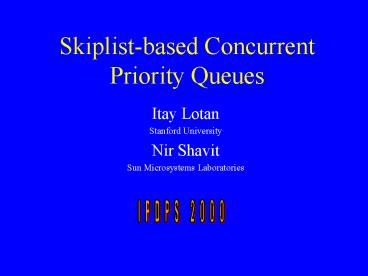Skiplist-based Concurrent Priority Queues - PowerPoint PPT Presentation
Title:
Skiplist-based Concurrent Priority Queues
Description:
Best solution Heap algorithm of Hunt et al. Works better than binary ... The Heap structure of Hunt et al ... SkipQueues scale significantly better than Heaps ... – PowerPoint PPT presentation
Number of Views:69
Avg rating:3.0/5.0
Title: Skiplist-based Concurrent Priority Queues
1
Skiplist-based Concurrent Priority Queues
- Itay Lotan
- Stanford University
- Nir Shavit
- Sun Microsystems Laboratories
IPDPS 2000
2
Priority Queues For Large-Scale MultiProcessor
Machines
- Priority Queue A data structure that allows n
asynchronous processes to insert an item, or
delete the item with highest priority - Large Scale Machine Hundreds of Processors
- Usually different architecture than small scale
machines
3
Fixed Set Priority Queue
- A priority queue with a fixed and predetermined
set of priorities - Used by operating systems to distribute CPU time.
- There is a scalable solution - Funnel Tree
Shavit, Zemach
4
General Priority Queue
- Supports an unlimited range of priorities
- Between any two priorities may be another
- Useful for
- Heuristic searches
- Graph searches
- Best solution Heap algorithm of Hunt et al
- Works better than binary search trees
5
Heaps Hunt et al
6
Scalability Problem of Heaps
Contention hot spots
7
New Approach - SkipQueues
- Based on Skip List of Pugh
- All locking is distributed and local
- Balancing of structure is probabilistic
- Deletions evenly distributed, minimal contention
- No need to pre-allocate memory
- All operations in expected logarithmic time
8
Coming up Next
- The inside story on concurrent Skip Lists Pugh
- How to make a SkipQueue
- Experimental Results
9
Skip List Structure Pugh
10
Inserting an Element
- Insert (key_t k)
- Randomly choose a level l
- Find at each level of the list up to l the
largest key smaller than k - For each level from 1 to l
- Acquire a lock on the item found before
- Insert the new key after it
- Release lock
11
Skip List - Insertion
New Item
12
Deleting an Element
- Delete (key_t k)
- Find k at all levels at which it appears.
- For each level from l to 1
- Acquire locks on k and the item before it.
- Remove k
- Release locks
13
Skip List - Deletion
14
SkipQueues
- Problem How to allow Delete_Min operations
without creating a bottle neck around the first
element?
15
Our Solution
- Observation - The lowest level of the Skip List
contains all the elements in ascending order - Processes can advance down this list and
logically delete the first available key - Each process can then delete the key that it
previously deleted logically
16
Delete_Min Operation
- Traverse the bottom level of the Skip List
structure - For each traversed Item
- Try to SWAP its Deleted flag
- If it was not already deleted, return the key of
the item - Else, go on to next item
- If at the end of the list, return EMPTY
- No locking at all
17
From Skip List to SkipQueue
18
Performance Benchmarks
- We compared the performance of 3 structures
- The Heap structure of Hunt et al
- FunnelList a simple linked list, access to
which is governed by a combining-funnel Shavit,
Zemach structure - SkipQueue structure as described before
19
Benchmark Methodology
- We used the Proteus multiprocessor simulator by
Brewer et al - We simulated a 256 processors machine similar to
the MIT Alewife - Processors alternate between performing small
amount of work and accessing the queue.
20
Benchmark Methodology Contd
- Processors randomly choose whether to insert or
delete - Priorities of inserted items are chosen uniformly
at random - We measured the average latency of Insert and
Delete_Min operations
21
Small Structure - Deletions
22
Small Structure - Insertions
23
Large Structure - Deletions
24
Large Structure - Insertions
25
Large Structure Benchmark With 70 Deletions -
Deletions
26
Large Structure Benchmark With 70 Deletions -
Insertions
27
Conclusions
- SkipQueues scale significantly better than Heaps
- SkipQueues are highly distributed no hot spots
or bottle necks - Deletes are 3 times faster and Inserts are 10
times faster when concurrency reaches 256
processors - Future Directions
- Implementation without locks
- Experimenting with other data structures
28
Delete_Min Contd
- In order to assure a stronger ordering property
we added the following - Each item is timestamped when its insertion is
completed - Each Delete_Min operation notes the time at which
it begins - The Delete_Min operation will only try to
logically delete items that were inserted
before it started.
29
Serialization Order
- Each successful Delete_Min is ordered at the time
its logical deletion was completed - Each unsuccessful Delete_Min that returned EMPTY
is ordered at the time of its return instruction - Each uncompleted Delete_Min is ordered at the
time of its invocation
30
SkipQueue Specification
- For every Delete_Min operation
- Let I be the set of keys inserted by Insert
operations serialized before it - Let D be the set of keys removed by Delete_Min
operations serialized before it - The returned value is the smallest in the set I
D, or EMPTY if I D is empty.































